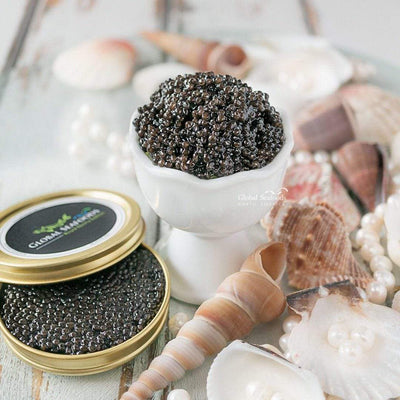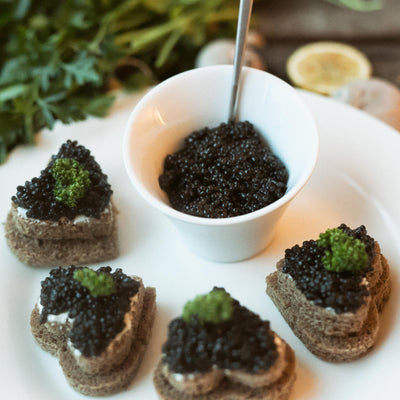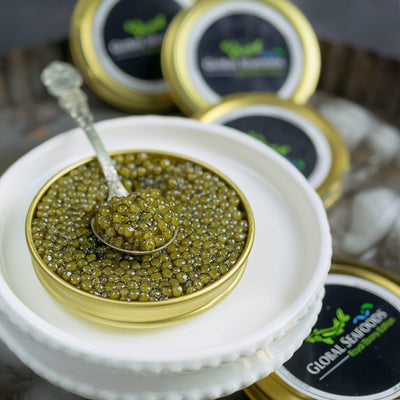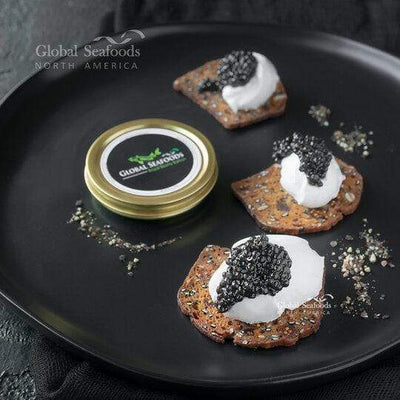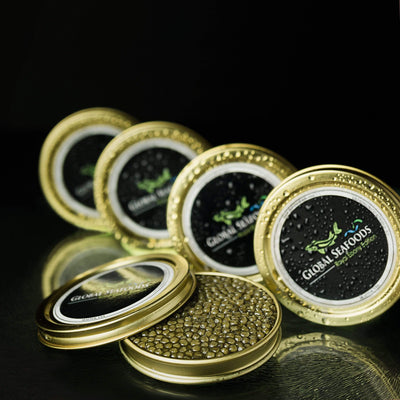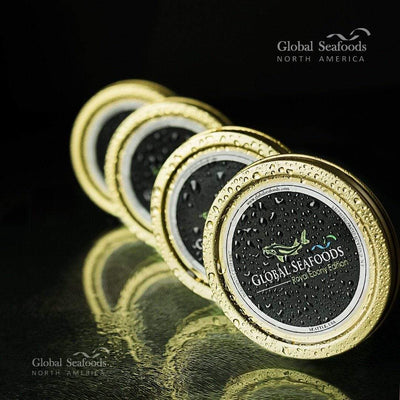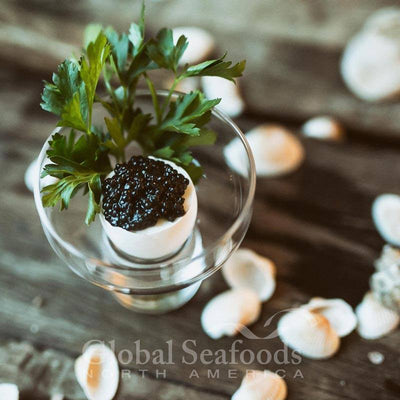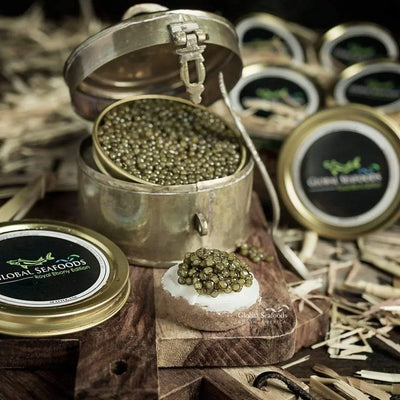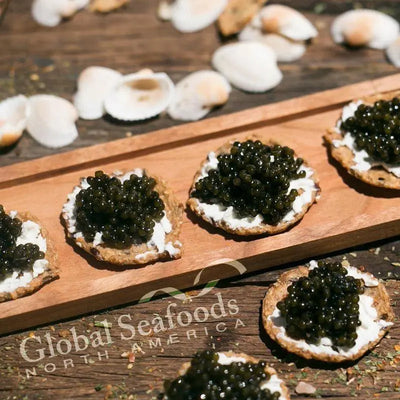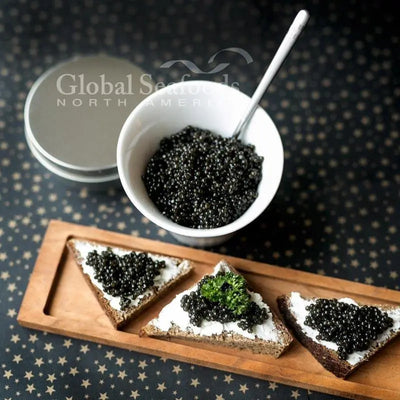Osetra Caviar vs. Sevruga Caviar: A Complete Guide to Choosing the Best

Osetra Caviar vs. Sevruga Caviar
When it comes to luxury delicacies, Osetra and Sevruga caviar stand out as two highly prized varieties, each offering distinct flavors, textures, and aromas. Whether you’re a caviar enthusiast or new to the world of fine dining, understanding the nuances of these caviar types can elevate your appreciation of this exquisite delicacy. This article provides a comprehensive comparison of Osetra and Sevruga caviar, helping you choose the perfect option for your next gourmet experience.
Explore the Global Seafoods YouTube Channel for Caviar Tips & More!
1. What is Caviar?
Caviar is a gourmet delicacy made from the salt-cured eggs (roe) of sturgeon fish. It is traditionally associated with luxury, and its rich, complex flavors have made it a sought-after treat in fine dining circles worldwide. Although all sturgeon caviar is prized, each type has unique characteristics that appeal to different tastes.
2. Origins of Osetra and Sevruga Caviar
Osetra and Sevruga caviar are harvested from two species of sturgeon found primarily in the Caspian Sea. The ancient history of these sturgeons and the traditional harvesting methods add to the appeal of their caviar. Russia and Iran have historically been major exporters, but today, sustainable farming has become prominent worldwide, providing high-quality Osetra and Sevruga caviar from both wild and farm-raised sources.
3. Types of Sturgeon Fish for Caviar Production
Caviar production relies on a few primary sturgeon species, each of which produces distinctive roe:
- Beluga Sturgeon: Known for the largest eggs and mild flavor.
- Osetra Sturgeon: Mid-sized eggs with a rich, nutty taste.
- Sevruga Sturgeon: Smaller eggs with a more intense, briny flavor.
Each species' unique environment influences the flavor and size of its caviar, making each variety ideal for different culinary experiences.
4. Defining Features of Osetra Caviar
Osetra caviar is derived from the Acipenser gueldenstaedtii sturgeon, which typically weighs between 50-400 pounds. Known for its firm, medium-sized eggs, Osetra caviar ranges from golden to dark brown in color, offering a rich, nutty flavor that has been described as buttery with hints of the sea.
"Caviar should be the symbol of nature, of freshness, of the taste of the sea." - Kaviari (a renowned French caviar producer)
For those seeking authentic Osetra, options like the Ossetra Sturgeon Caviar from Global Seafoods deliver premium quality.
5. Defining Features of Sevruga Caviar
Sevruga caviar, derived from the Acipenser stellatus sturgeon, is distinctive for its small, soft eggs and its gray or silver color. The flavor is robust, briny, and complex, appealing to those who appreciate a more intense caviar experience. Due to its smaller eggs, Sevruga is often favored by those who prefer a pop of flavor that spreads evenly across the palate.
For high-quality Sevruga, explore options like the Sevruga Sturgeon Caviar from Global Seafoods.
6. Flavor Profile Comparison
Osetra and Sevruga caviars offer distinctly different taste experiences:
- Osetra: Known for its buttery, nutty flavor, with a medium firmness that releases a subtle briny flavor.
- Sevruga: Offers a saltier, more oceanic taste, appealing to those who prefer intense, sharp flavors.
For beginners, Osetra may be more accessible due to its balanced taste, while Sevruga is ideal for those seeking a more profound flavor experience.
7. Texture and Appearance Differences
Osetra caviar features larger, firmer eggs that feel substantial and luxurious, with a satisfying pop. In contrast, Sevruga caviar has smaller eggs with a softer texture that melts quickly on the tongue. Osetra’s eggs are amber or golden brown, while Sevruga presents in silvery-gray, adding visual distinction when served.
8. Nutritional Value of Osetra vs. Sevruga
Both caviar types offer valuable nutrients, including omega-3 fatty acids, vitamins A, D, and B12, and high-quality protein. They support cardiovascular health, boost immune function, and contribute to overall well-being. Both types are nutrient-dense, making them a health-conscious indulgence.
9. Cost Comparison
Typically, Osetra caviar is more expensive than Sevruga due to the sturgeon's longer maturation period and slightly larger eggs. However, prices can vary widely based on sourcing, production, and availability. For instance, California White Sturgeon Caviar offers an Osetra-like experience at a more accessible price point.
10. Culinary Uses and Pairing Suggestions
Both Osetra and Sevruga caviars shine in dishes that allow their natural flavors to be the star. Serve them:
- On Blinis: Light, soft pancakes that complement without overwhelming.
- With Crème Fraîche: Adds richness and balances saltiness.
- On Deviled Eggs: Elevates the classic appetizer with a luxurious touch.
Pairing with beverages like Champagne or a light vodka enhances the delicate flavors. For an alternative option, Kaluga Caviar also pairs well with similar accompaniments.
11. How to Properly Serve Caviar
To enjoy the full flavors of caviar, serve it chilled on a non-metallic spoon or dish. Traditional materials like mother-of-pearl, glass, or ceramic ensure that no metallic taste interferes with the experience. Serve with minimal garnish to let the caviar shine.
12. Sustainable Caviar Sourcing
Due to concerns over sturgeon populations, sustainable sourcing has become a priority. Ethical caviar providers like Global Seafoods focus on farm-raised sturgeon, ensuring eco-friendly production without compromising quality.
FAQs About Osetra and Sevruga Caviar
Q1: Which is better, Osetra or Sevruga caviar? A1: Neither is inherently better; the choice depends on personal taste. Osetra is mild and nutty, while Sevruga is saltier and briny.
Q2: Can I pair caviar with wine? A2: Yes, dry Champagne or crisp white wines complement caviar well by balancing its richness.
Q3: How long can caviar be stored? A3: Unopened, caviar can be stored in the coldest part of your fridge for up to 4 weeks. Once opened, consume within 2-3 days.
Q4: What is the best way to serve caviar? A4: Serve caviar chilled, with a mother-of-pearl spoon, on blinis or with light accompaniments.
Q5: How does Osetra caviar taste compared to Beluga? A5: Osetra is buttery and nutty, while Beluga is milder and creamier.
Q6: Where can I buy quality caviar online? A6: Trusted online sources like Global Seafoods offer a variety of high-quality options.
14. Where to Buy Authentic Caviar
For guaranteed quality and variety, Global Seafoods provides a wide selection of premium caviar types, from Siberian Sturgeon to Beluga and Kaluga caviar.
Conclusion: Choosing the Right Caviar
The choice between Osetra and Sevruga ultimately depends on personal preferences. Whether you favor the mild, nutty richness of Osetra or the intense, briny pop of Sevruga, caviar promises a luxurious and memorable experience. For those new to caviar, sampling different varieties will allow you to appreciate each type's unique qualities.
Also in News

How to Make Sea Bream Sushi With Dry-Aged Tuna & Crab Roll — Step-by-Step With Chef Joshua
A complete guide to making Sea Bream sushi at home, including filleting, curing, slicing, and building a Dry-Aged Tuna & Crab sushi roll. Chef Joshua shares professional tips for restaurant-quality results.

Boiled Crab for Game Night: Everything You Need for a Perfect Seafood Party
Take your game night to the next level with a Boiled crab party. Learn the best recipes, cooking tips, and hosting hacks for a memorable seafood feast.

Boiled Crab for Date Night: A Romantic Guide to the Perfect Seafood Feast
Make your next date night unforgettable with a romantic Boiled crab experience. This guide covers everything you need to know, from ambiance to the best crab varieties.

